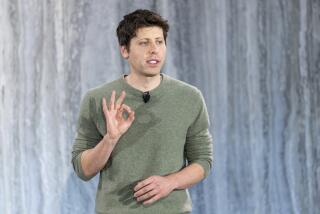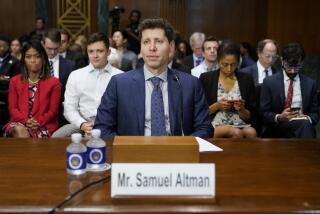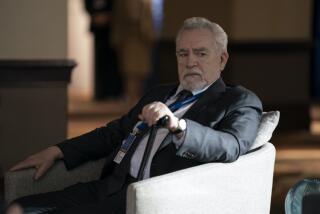NEWS ANALYSIS : Power Struggle Led to Ouster of AST’s Yuen, Insiders Say : Computers: Safi Qureshey ‘pulled a coup,’ a source said of the co-founder who now heads the Fortune 500 company.
IRVINE — The computer industry hummed with speculation this week: Why did co-founder Thomas C. K. Yuen leave AST Research Inc.?
Neither Yuen nor Safi U. Qureshey, chief executive and the last of three immigrant co-founders remaining at the rags-to-riches Fortune 500 company, is talking to the news media since Yuen’s abrupt departure Monday.
But there is a consensus among current and former employees and other followers on what transpired at one of the nation’s hottest manufacturers of personal-computer “clones.” Yuen left, they say, after throwing down the gauntlet and then losing a monthslong power struggle with Qureshey, with whom he shared the title of co-chairman.
“He is bitter about what is happening,” said one source, who asked not to be identified. “Tom got ousted.”
Said another: “Safi pulled a coup.”
Carmelo J. Santoro, who was appointed chairman on Monday, said the departure was not related to Yuen’s health. Yuen suffers from a severe kidney condition that has nearly taken his life twice. Last week, Santoro said, he and another outside director, Richard J. Goeglein, presented a report to the board on the company’s management and AST’s industry position.
Santoro said the review by outside directors began about three months ago at the request of both Yuen and Qureshey.
Yuen may have lost the struggle because his abrasive management style, while decisive, had earned him few friends among the executives and board members.
“He could be an a------,” one former executive said. “But he could do the work.”
Santoro said the review did not focus on Yuen’s management style. He would not provide more details. Whatever happened, the departure of Yuen further tarnishes the image of the company’s unusual “Three Musketeers” management style that the founders--Qureshey, Yuen and Albert C. Wong--fostered early on.
When they conceived the company more than a decade ago, Yuen and Qureshey were engineers at a minicomputer company who were frustrated by the slowness with which they were moving up the corporate ladder. Wong, who had been Yuen’s college roommate, was often considered the odd man out. Though Wong was a technical wizard, Qureshey and Yuen had personal ties that bound them. For instance, both had married Japanese women.
“We had some common background, an affinity, and we both bitched a lot,” Yuen said in an interview in April.
Egalitarian from the beginning, they named the company using the initials of their first names and determined their original job titles by picking them out of a hat.
They started up the operation in a garage in July, 1980, and they hit the jackpot with their first product, an add-on memory board for the first International Business Machines Corp. PC.
Soon enough, they were all millionaires, and AST was growing beyond the expectations of all who followed it. In 1987, the three men set up an executive committee that included senior executives. That group became the guiding force of AST, and its formation ensured that AST could steer itself regardless of who left.
For a while, the three managed to divide their duties. Wong ran engineering. Yuen made marketing decisions and day-to-day decisions. Qureshey oversaw finance, courted international and domestic customers, and talked to Wall Street and the media. But tensions developed when strong personalities came into conflict and lines of responsibility were vague.
The partnership shattered in November, 1988, when Wong clashed with Yuen over a product launch and resigned in the heat of the moment. Rather than try to bring Wong back, the remaining co-founders began spread the word that the Three Musketeers were now two.
Two months later, AST ran aground in an industrywide slowdown. It reported its first quarterly loss and laid off 6% of its work force. Yuen and Qureshey were taken aback when Wong suggested in the media that the company needed “more professional management.”
Qureshey then took charge of engineering projects in addition to dealing with the outside world. When the media called for interviews, Qureshey was always available. Yuen took over day-to-day decision-making and marketing.
Under that arrangement, AST began a recovery that catapulted it into the top ranks of the PC market and brought it praise from analysts who had written it off in 1989. Even Wong was astounded, and he credited his former colleagues.
On a personal level, though, success wasn’t all it was cracked up to be. Qureshey spent much of his time tending to his daughter, who had been in an accident and required constant medical attention.
And Yuen was was undergoing dialysis several times a week for his kidney problems. Although he never seemed to lose his zeal for running the business, some managers avoided making proposals to him on Tuesdays and Thursdays, when the painful treatments were likely to make him irritable. Yuen wanted to find a cure for his ailments, and his thoughts constantly wandered to biotechnology instead of computers.
Steadily, the engineers whom Wong had assembled left the company, a few of them joining him at his rival start-up computer company.
Tom Ludwig and Tom Craft, two engineering chiefs who along with Wong had designed AST’s most successful machines, quit and started their own company.
Because the project had been scuttled by superiors, the two men secretly designed AST’s first notebook computer, a model small enough to fit in a briefcase. Sales of the machine accounted for about 30% of AST’s revenue of $688.5 million for the fiscal year ended June 30, 1991.
AST, meanwhile, was looking and acting less like a partnership and more like a big corporation. The computer industry went through a withering price war during 1991. In November, Yuen brought his managers together and threw a tantrum similar to a widely publicized bout of rage by former IBM executive John F. Akers.
Those familiar with the company’s operation say the final struggle between Yuen and Qureshey began several months ago after Yuen decided that he should run the company’s entire operations. Some executives say they were not aware that rifts had developed between the pair, who rarely argued publicly.
But Yuen apparently wanted control. He knew how to run the company and wanted more authority, but Qureshey had the support of the board. Perhaps because of his abrasive style, few aligned themselves with Yuen.
Specific points of contention included delays in the company’s multiprocessing computer project, which has been in the works for more than two years. The project was supervised by Qureshey, who unsuccessfully tried to get the industry to accept standards for the new technology.
Another was the company’s second-generation notebook computer project, led by Yuen. Delays arose when marketing officials asked engineers to redesign the computer to fit the changing market needs.
Meanwhile, lines of authority were blurring, employees said, sometimes leading to confusion. Qureshey and Yuen dabbled in each other’s projects. Yuen even got some of the media limelight, a change from previous policy. Rival camps, supporting either Yuen or Qureshey, developed among the lower ranks.
“AST had too many chiefs,” Wong said after Yuen’s departure was announced.
Last week, Santoro made his recommendations to the five-member board of directors, including a suggestion that the company would be more efficient with a single chief executive.
“Part of the streamlining process is to have a single person in control of day-to-day operations,” said Michael Morand, vice president of marketing.
On Monday, the company announced that Yuen had resigned. A memo to employees made no mention of the man’s contributions to the company.
Opinions vary on how much Yuen will be missed. The company’s stock actually rose on Wall Street this week. Analysts say that it makes sense to have a single chief executive during a rocky period in the computer industry.
The company “is like a big ship, moving forward,” one former engineer said. “But AST has not introduced anything great lately.”
A manager still with the company said of Yuen’s departure: “We’re sad, but you move on. . . . It’s for all the right reasons.”
Those who were Yuen loyalists, however, say that he was the executive who controlled the day-to-day profitability and crucial inventory control. They wonder if Qureshey can carry the burden alone.
“No one co-founder was responsible for the success, but Tom contributed more than anyone else,” said Chuck Cortright, a former AST marketing executive. “He could be a tough cookie, but he had a sixth sense for the market.”
Others say giving too much credit to Yuen isn’t fair to Qureshey. Genelle Trader, who left a marketing director position at AST four months ago, said she thinks Qureshey is up to the challenge.
“Safi is wise, and he sees the value of keeping people happy,” she said.
“I’m sad to hear it,” she said of Yuen’s leaving, “because Tom put so much into the company. But it’s a public company, and sometimes there has to be change.”
When Wong left AST, it was months before the founders began sharing their painful stories about the reasons. That is likely to be the case with Yuen too.
“Personalities play into things. It’s not something that you stand on a pedestal and tell everyone about,” one employee said.
More to Read
Inside the business of entertainment
The Wide Shot brings you news, analysis and insights on everything from streaming wars to production — and what it all means for the future.
You may occasionally receive promotional content from the Los Angeles Times.










